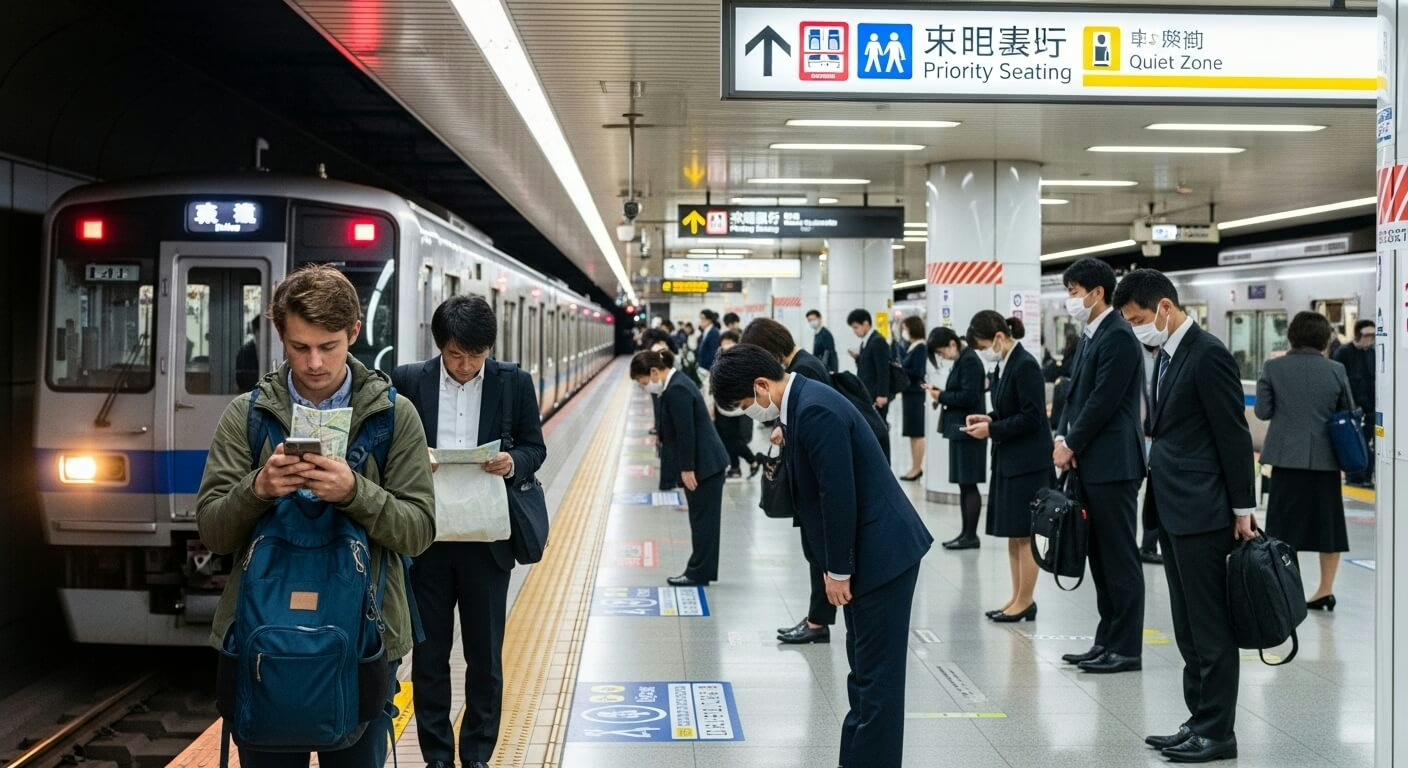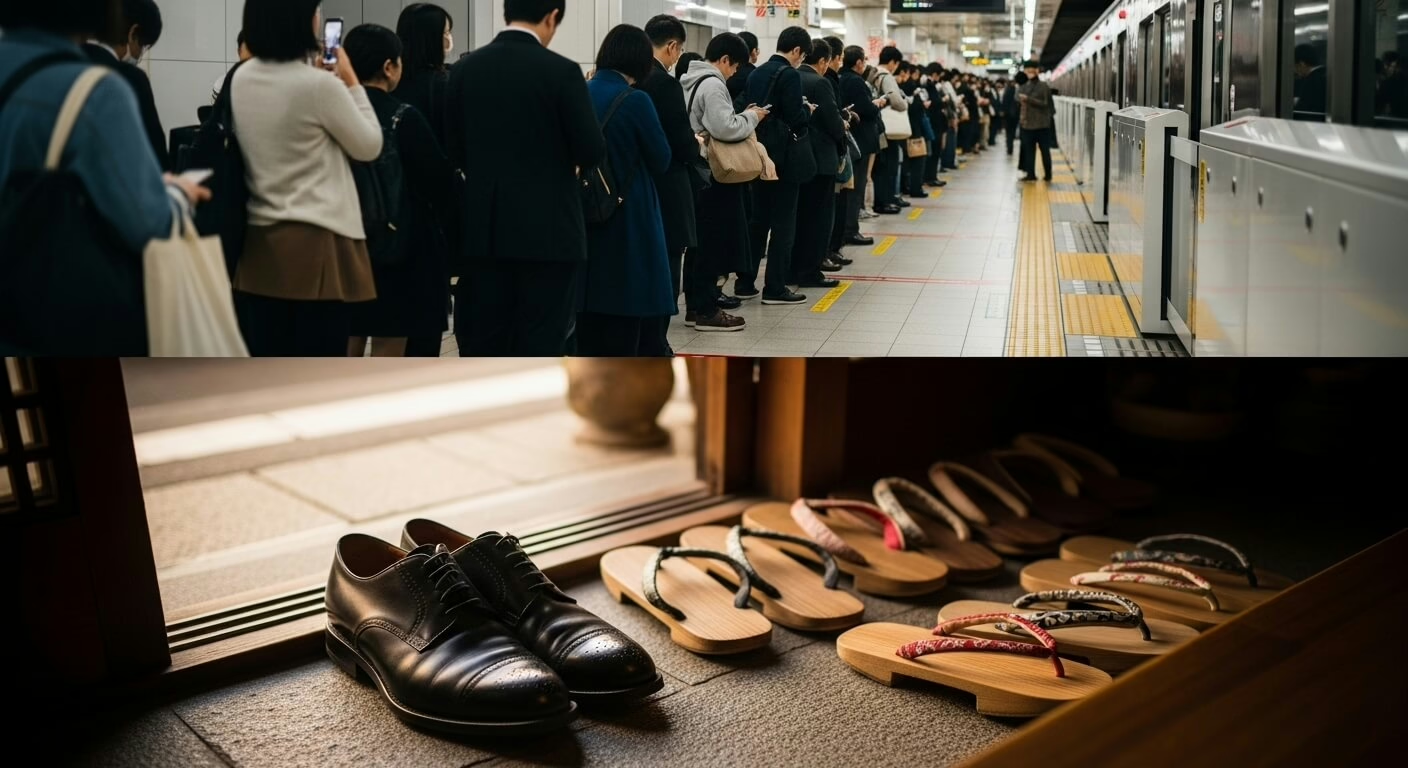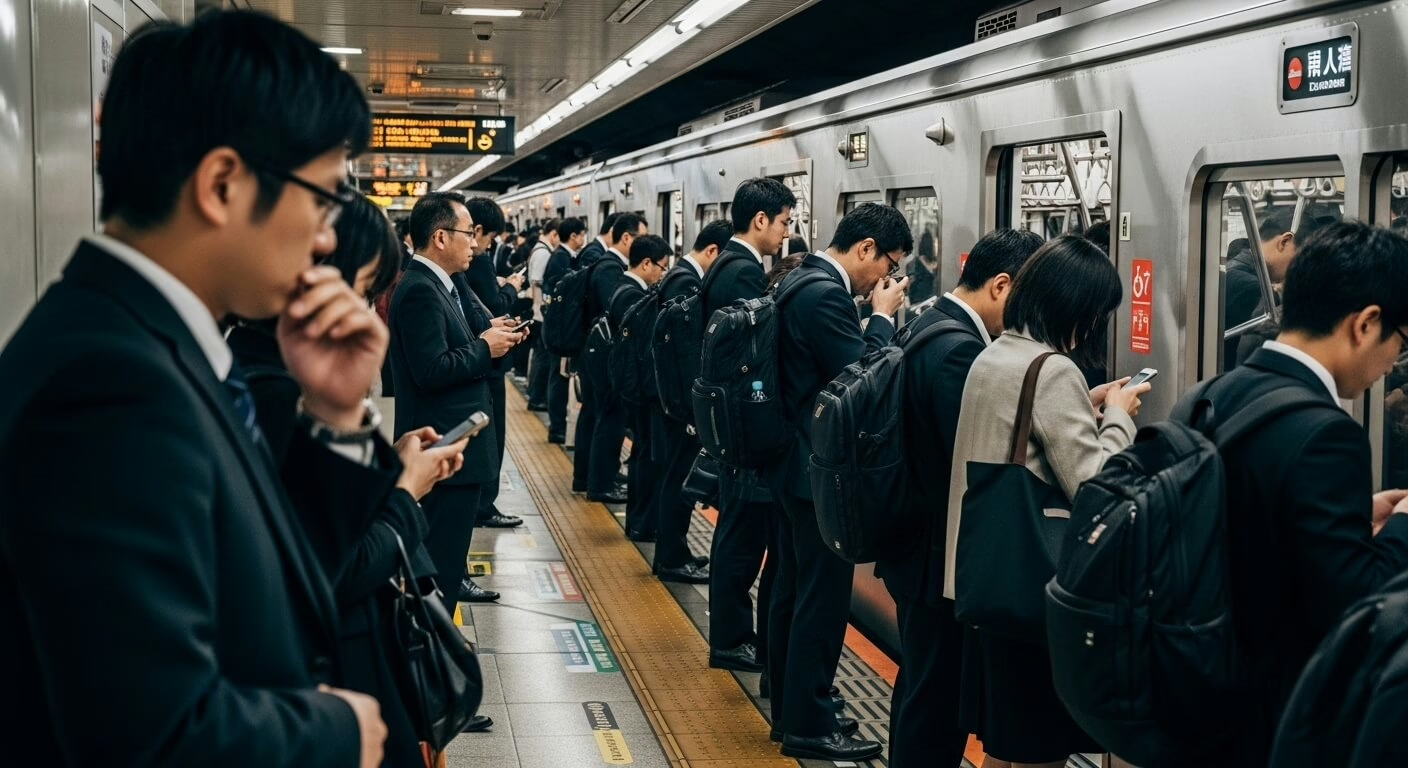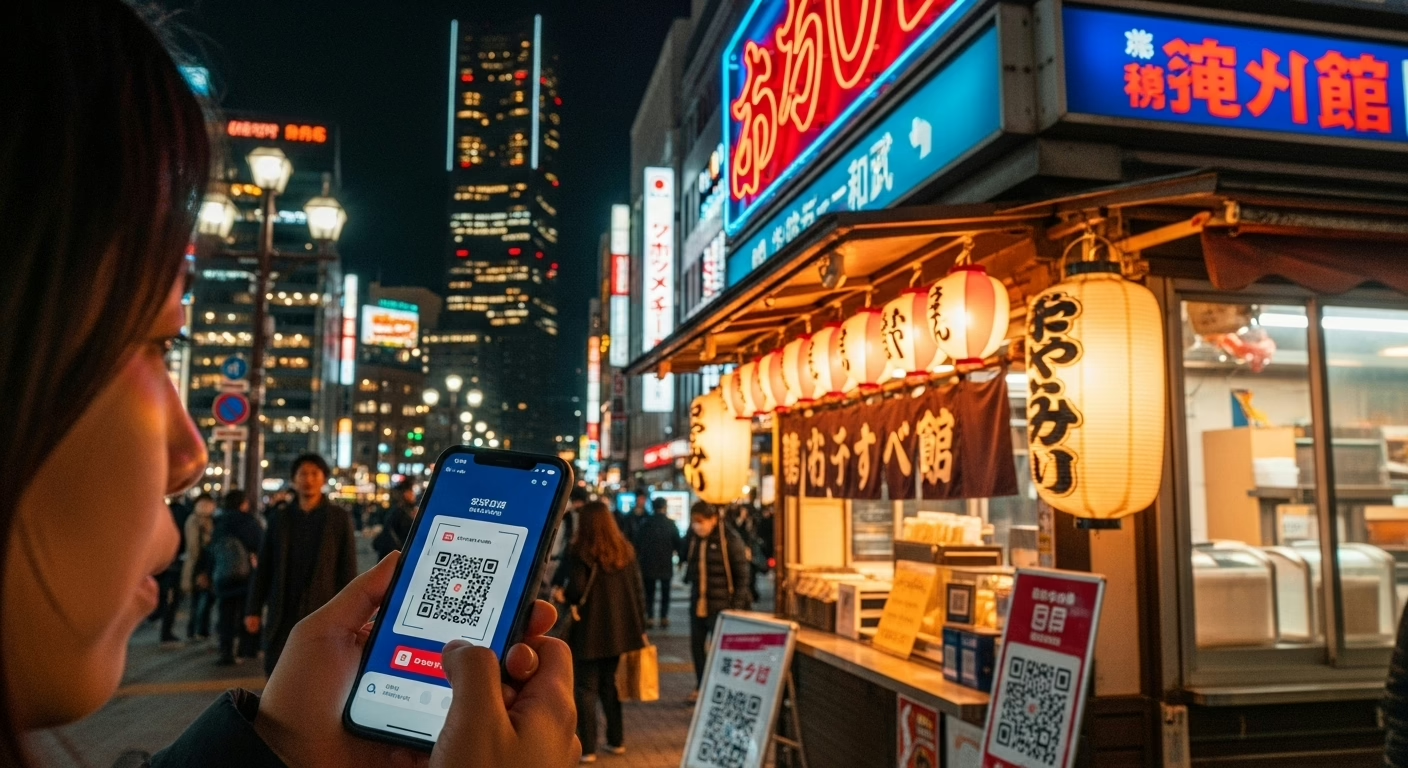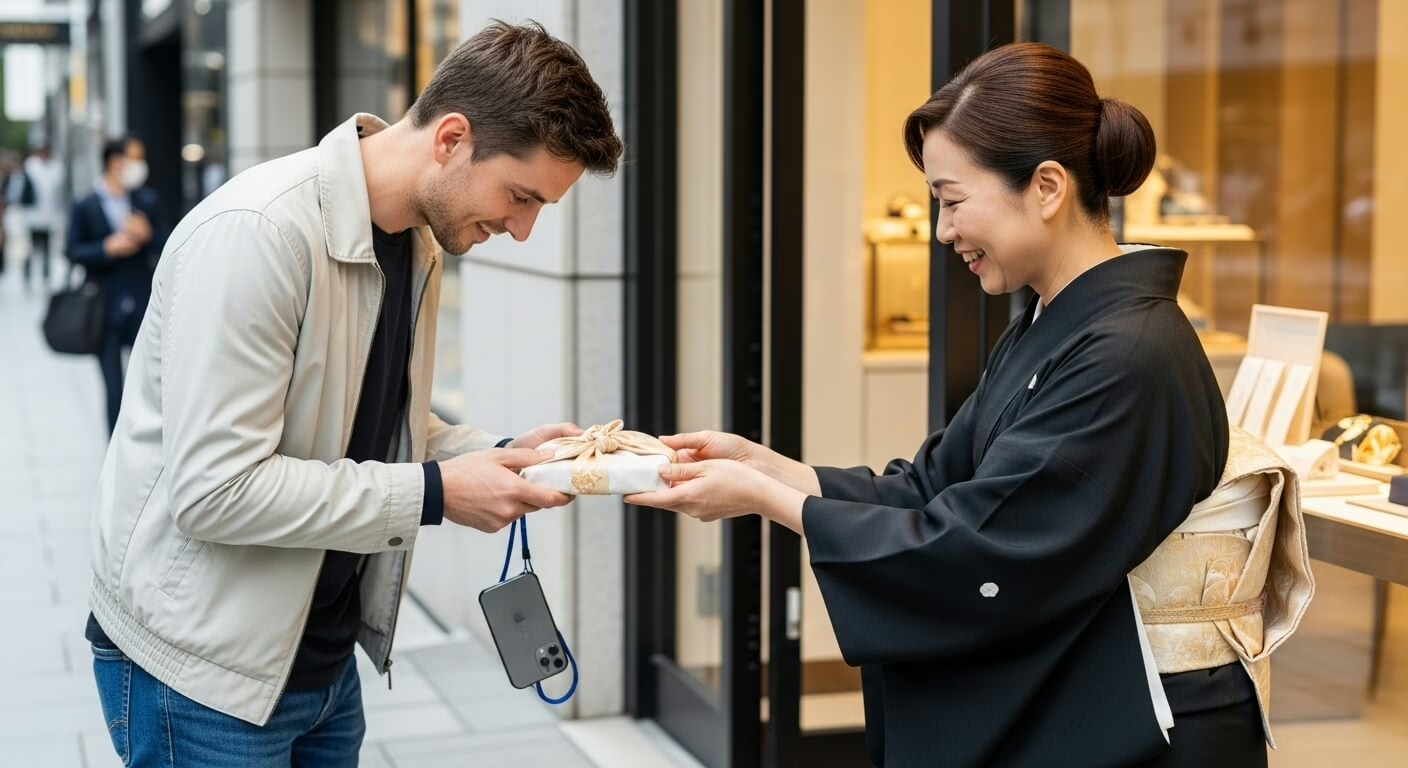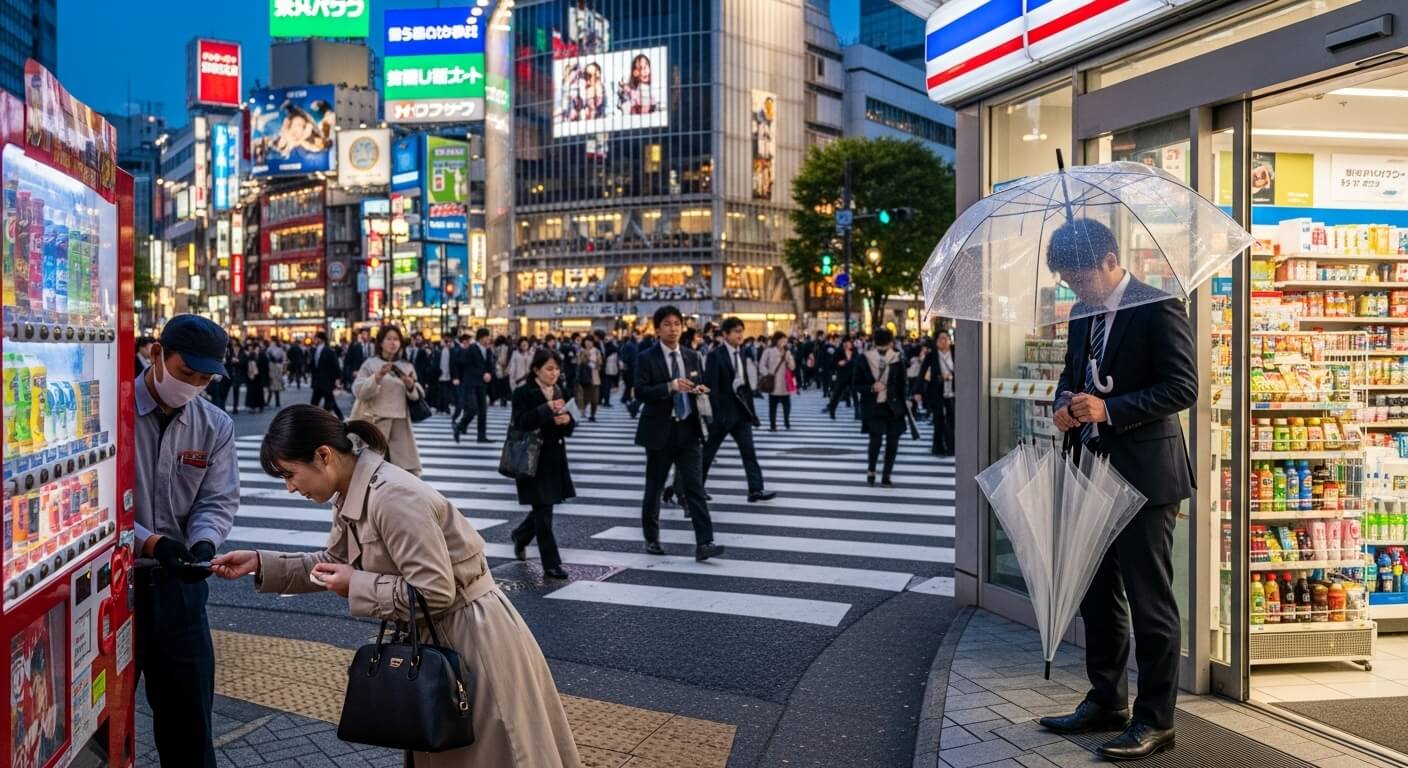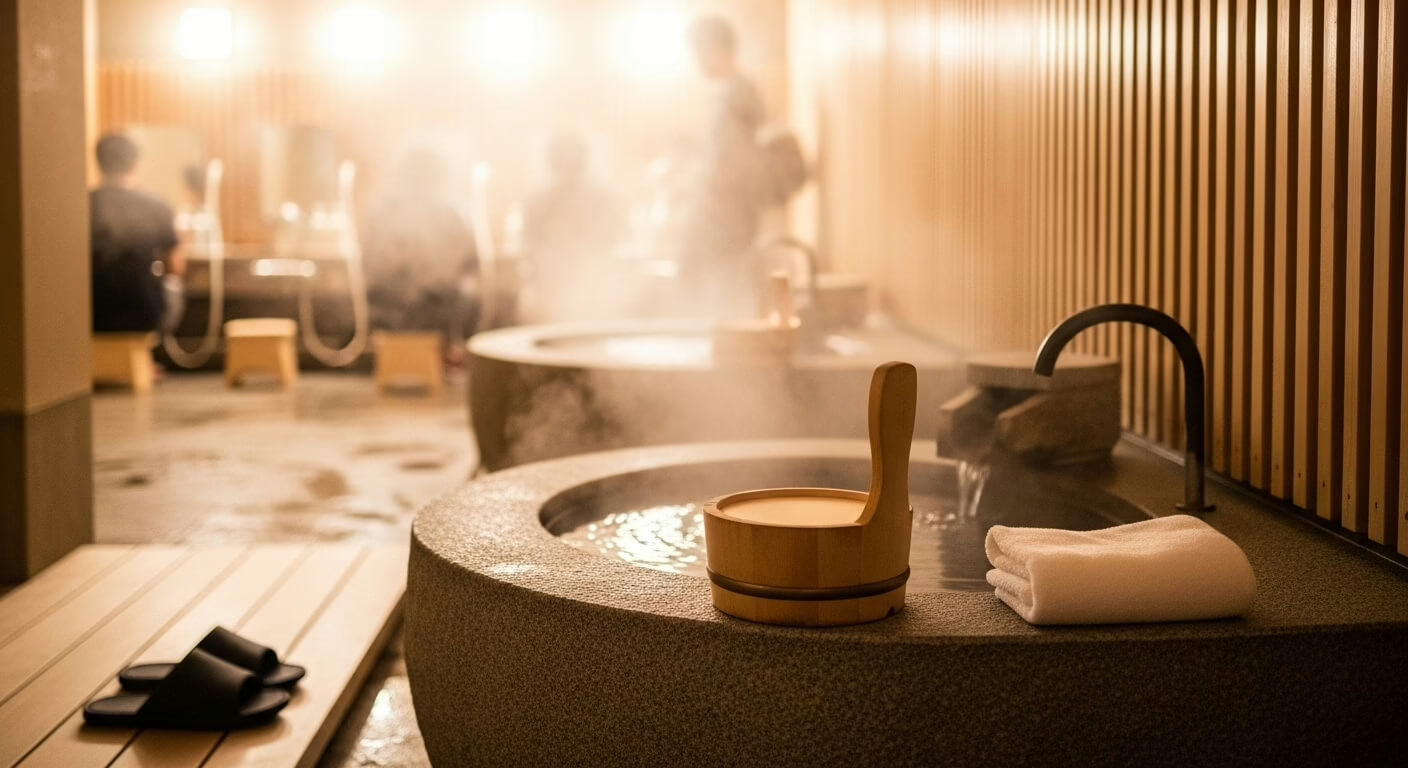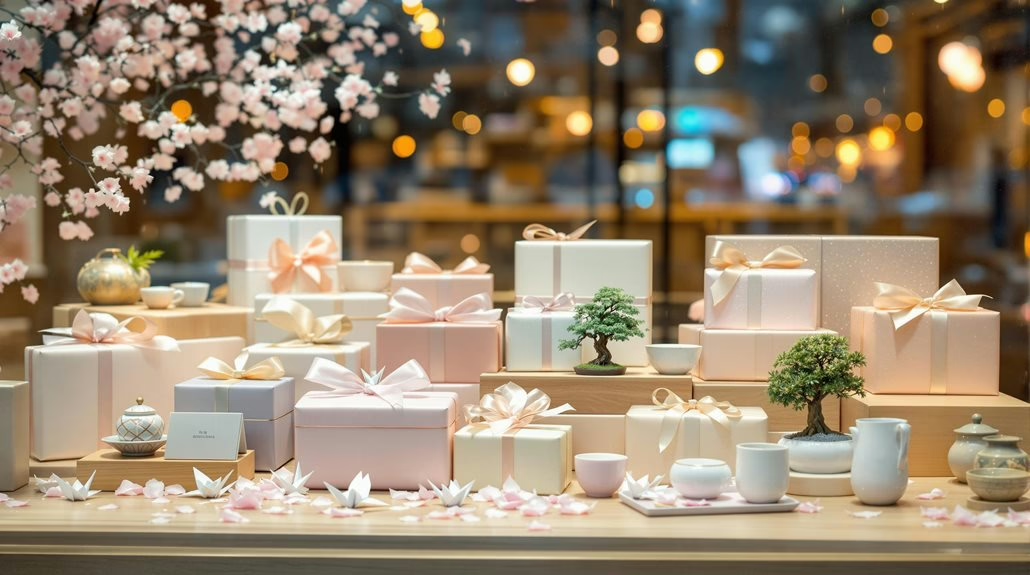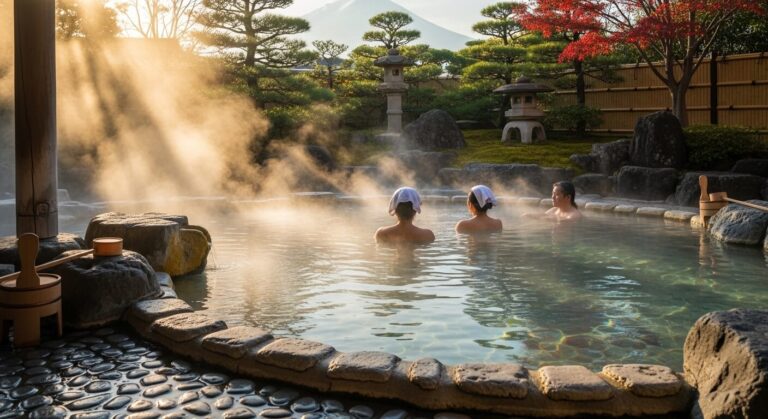Tokyo Etiquette Guide: Do’s and Don’ts for First-Time Visitors
Your Complete Etiquette Guide: Essential Rules for First-Time Visitors – Tokyo’s etiquette centers on “meiwaku”—avoiding trouble for others—which shapes everything from whisper-quiet train rides to carrying your trash home.
Visitors should bow slightly when greeting, remove shoes at entryways, never tip (it’s insulting!), and skip phone calls on public transit entirely.
Chopsticks should rest horizontally on holders, not stuck vertically in rice, while eating on-the-go generally remains taboo except in designated areas.
Master the purification ritual at temples by rinsing hands then mouth at the water pavilion before approaching shrines.
These customs *open* Tokyo’s deeper rhythms beyond surface-level tourism.
Key Takeaways
Hide- Avoid causing "meiwaku" (trouble for others) by keeping quiet on trains, not eating while walking, and being spatially aware in public.
- Maintain library-level silence on public transport, switch phones to silent mode, and never make phone calls on trains or subways.
- Use chopsticks properly: never stick them vertically in rice, pass food chopstick-to-chopstick, or point at people with them.
- Pay restaurant bills at the front register, not at the table, and never tip as it's considered insulting.
- Purify hands and mouth at temple water pavilions before entering, and bow twice, clap twice, then bow once when praying.
Tokyo Do’s and Don’ts: Navigate Japanese Customs Like a Respectful Traveler
Tokyo’s social fabric operates on a fundamentally different wavelength than Western cities, where individual expression often takes center stage—here, the invisible thread connecting everyone is the concept of “meiwaku,” or avoiding causing trouble for others.
Tokyo Trip Add-Ons
Equip yourself for the ultimate Tokyo adventure with the following add-ons, curated just for you.
This isn’t just polite behavior you can shrug off; it’s the operating system running beneath every interaction, from the hushed conversations on packed morning trains to the meticulous way people organize their trash into seven different categories.
- Tokyo Free Museum Days: When to Visit Without Paying
- Monthly Tokyo Living: Budget Tips for Long Stays
- Navigating Tokyo’s Airports: From Narita to Haneda Smoothly
- Tokyo Pharmacy Guide: Where to Buy Medicine & Toiletries
- Summer Matsuri Guide: Summer Festival Tips in Tokyo
- Tokyo Discount Coupon Guide: Where to Find Tourist Savings
Understanding why Japanese manners carry such weight transforms Tokyo from a confusing maze of unspoken rules into a city where millions of people create daily harmony through thousands of tiny, considerate actions!
Why Japanese Manners Matter More Than You Think
What makes Japan’s capital so remarkably orderly, clean, and harmonious despite cramming 14 million people into one metropolitan area?
The answer lies in a deeply ingrained respect for collective harmony that shapes every social interaction.
Understanding Japanese bowing customs isn’t just about politeness—it’s your passport to genuine connection, signaling respect and awareness that locals genuinely appreciate.
Gift exchange etiquette operates similarly, where presentation matters as much as the present itself, wrapped beautifully to honor the recipient.
These customs aren’t arbitrary rules designed to restrict you; they’re social lubricants that make maneuvering through crowded trains, bustling restaurants, and packed streets surprisingly pleasant!
When everyone follows these unwritten codes, personal freedom actually expands because predictable behavior creates mutual trust and surprisingly liberating social efficiency.
The Concept of “Meiwaku” and How It Shapes Daily Life
Have you ever wondered why Japanese people seem almost telepathically coordinated in public spaces, moving through packed train stations without collisions or raised voices?
The secret lies in meiwaku—a powerful concept roughly meaning “causing trouble or inconvenience to others.” This single word shapes virtually every interaction in Tokyo, from speaking quietly on trains to meticulously sorting garbage.
Unlike Western cities where individual expression often trumps collective comfort, Tokyo operates on an unspoken agreement: your freedom ends where someone else’s peace begins.
Meiwaku behavior—loud phone conversations, blocking sidewalks, eating while walking—disrupts social harmony and marks you as culturally tone-deaf.
Understanding this principle access Tokyo’s magic, transforming seemingly arbitrary rules into a beautiful choreography where eight million people coexist seamlessly!
Mastering Public Transportation Etiquette in Tokyo
Tokyo’s trains and subways run with clockwork precision, carrying millions of passengers daily through an intricate dance of unspoken rules that keeps the entire system flowing smoothly.
Visitors who master these transit customs—from priority seating protocols to phone etiquette—transform themselves from awkward tourists into respectful participants in one of the world’s most efficient transportation networks.
Knowing what behaviors to embrace and which ones to avoid can mean the difference between blending in seamlessly and accidentally becoming the source of dozens of disapproving glances during rush hour!
Train and Subway Rules Every Visitor Should Know

Tokyo’s trains and subways run like clockwork, but maneuvering the unspoken rules of conduct is just as important as mastering the route maps!
From maintaining library-like silence (yes, even during rush hour) to knowing exactly where to stand when those doors whoosh open, these etiquette essentials will transform visitors from confused tourists into respectful commuters who blend seamlessly with the crowd.
The good news is that once travelers understand the basics—keeping voices down, offering seats to those who need them, and queuing with Japanese precision—they’ll find that Tokyo’s public transportation becomes not just efficient, but genuinely pleasant.
Speaking Quietly and Phone Call Protocol
While whispered conversations and silent commutes might seem unusual to visitors from more gregarious cultures, maintaining a hushed atmosphere on Tokyo’s trains isn’t just polite—it’s practically sacred.
Speaking volume should hover around library levels, and phone etiquette demands switching devices to silent mode.
Actual phone calls?
Absolute no-go territory!
Text away freely, but save chatty catch-ups for after you exit.
Priority Seating: When to Offer Your Seat
How does one navigate the delicate dance of priority seating without committing a cultural faux pas?
Master priority seating etiquette by offering your seat to:
- Elderly passengers struggling with balance
- Visibly pregnant women wearing maternity badges
- People with disabilities or mobility aids
- Parents juggling small children
Stand promptly, gesture graciously toward the empty space, then move away—no elaborate explanations needed!
Boarding and Exiting: The Art of Queuing
Once you’ve mastered the generosity of giving up your seat, the next challenge awaits right there on the platform—where orderly lines form like perfectly synchronized choreography.
Tokyo’s queue discipline isn’t about restriction—it’s about respectful waiting that actually gets everyone moving faster!
Stand behind the painted platform markers, let passengers exit first, then board swiftly.
This elegant system transforms crowded stations into surprisingly smooth experiences, liberating you from the chaos you’d encounter elsewhere.
What to Avoid on Trains and Buses
Tokyo’s trains and buses come with a surprisingly strict set of unwritten rules about personal behavior, and breaking them will earn travelers more than a few disapproving glances from fellow commuters.
While sipping coffee or touching up makeup might seem harmless during a morning commute back home, these activities are considered inconsiderate on Japanese public transit—eating strong-smelling foods or applying mascara while the train sways can bother nearby passengers who value their shared space.
Meanwhile, bulky backpacks and oversized luggage present their own challenges in crowded cars, requiring travelers to master the art of spatial awareness before they accidentally whack someone during rush hour!
Eating, Drinking, and Makeup Application
Why do seemingly innocent activities like sipping coffee or touching up lipstick become major faux pas on Tokyo’s trains and buses?
Understanding eating etiquette and makeup tips prevents awkward stares:
- No eating (exception: shinkansen long-distance travel)
- Drinking water gets a pass, coffee doesn’t
- Makeup application signals poor time management
- Strong-smelling foods absolutely forbidden
Respecting these boundaries demonstrates cultural awareness!
Backpack and Luggage Management
Every rush hour commuter has experienced the dreaded backpack-to-face collision, and Tokyo’s packed trains make this scenario all too common—which is precisely why luggage etiquette matters so much here.
Remove your backpack and hold it at your feet or use designated luggage storage racks—your fellow passengers will silently thank you!
This simple move maximizes space while ensuring backpack security, letting everyone breathe easier during those sardine-can commutes.
Restaurant and Dining Customs That Will Save You Embarrassment
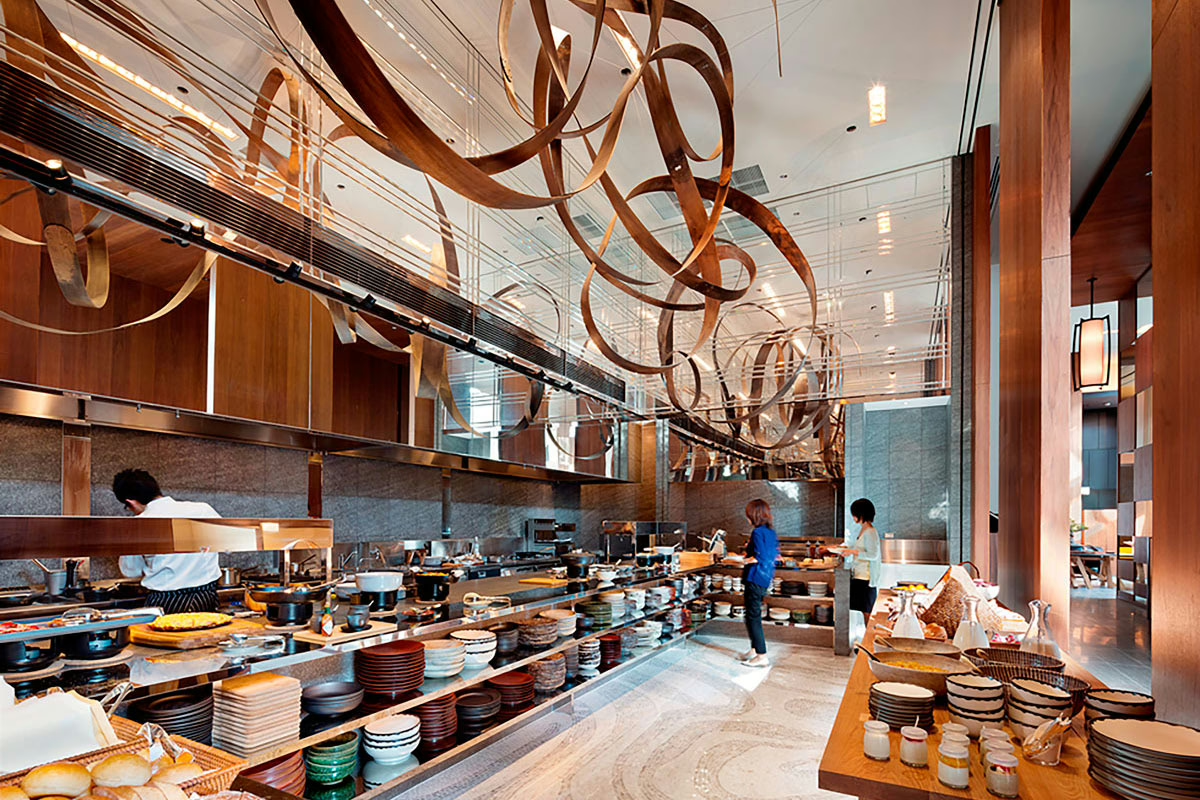
Tokyo’s restaurant scene comes with a fascinating set of unwritten rules that can make the difference between looking like a seasoned insider and accidentally insulting your server!
From the moment visitors step through those sliding doors—sometimes literally stepping out of their shoes—to the peculiar protocol of never, ever leaving cash on the table, dining etiquette here operates on a completely different wavelength than what most Westerners expect.
The good news is that once travelers understand these customs, from proper chopstick handling to why offering a tip might genuinely offend someone, steering through Tokyo’s incredible food culture becomes second nature.
Entering a Restaurant: From Shoes to Seating
The moment a visitor slides open the door to a traditional Tokyo restaurant, they’re stepping into a choreographed dance of customs that can feel utterly mystifying—but mastering these first few minutes will set the tone for an entire meal.
Avoiding cultural missteps starts at the entrance, where these etiquette nuances matter most:
- Remove your shoes at the genkan (entryway) when you spot raised flooring or slippers waiting.
- Wait to be seated—never choose your own table, even if the place looks empty.
- Accept the oshibori (hot towel) with both hands and use it only for your hands.
- Store bags on provided hooks or under your seat, never on the table.
These simple gestures signal respect and immediately earn you insider status!
Chopstick Etiquette That Actually Matters
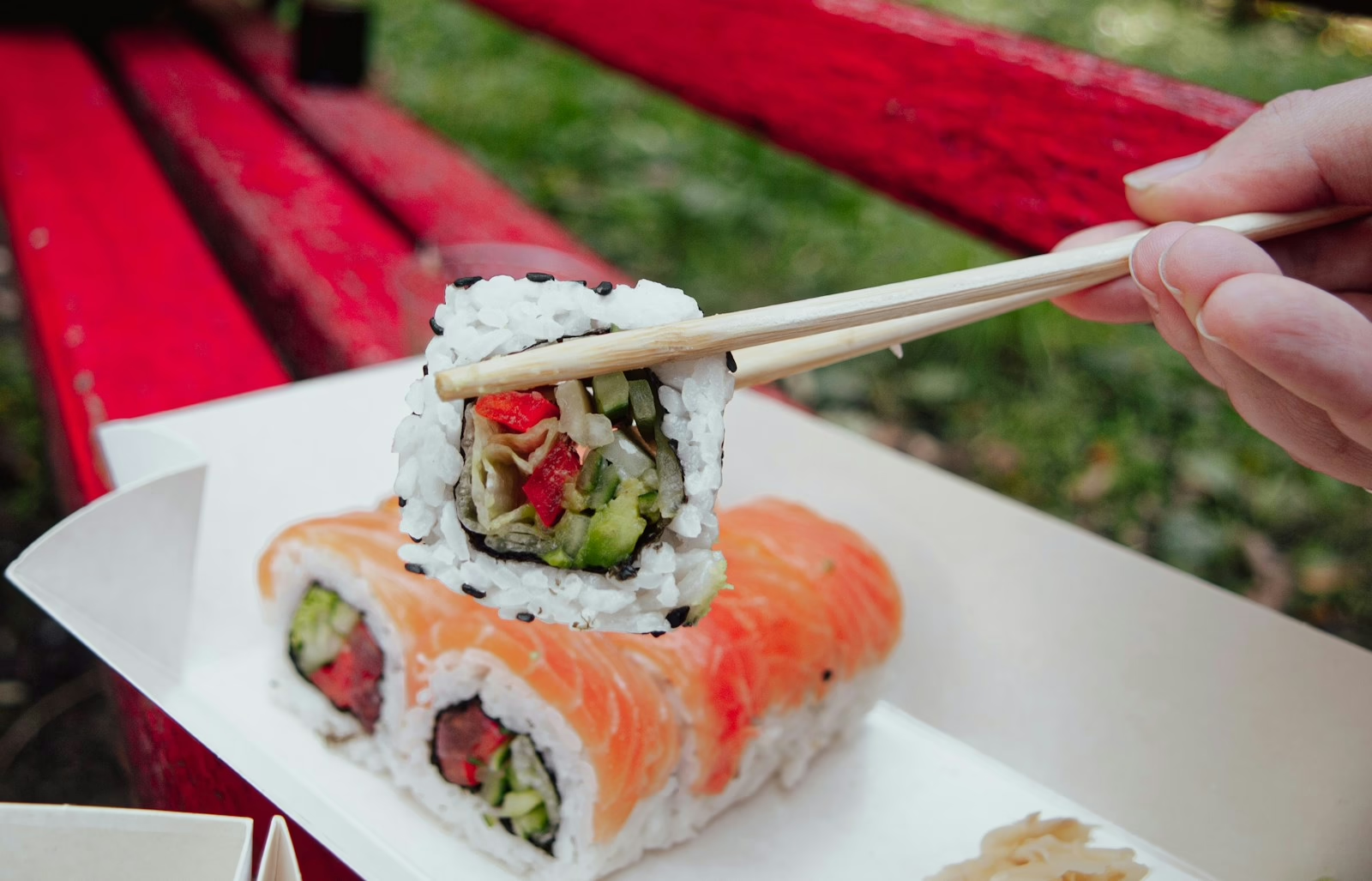
Mastering chopstick etiquette isn’t about perfecting your grip—it’s about avoiding three cardinal sins that’ll make everyone at the table uncomfortable.
Never stab food with chopsticks (it’s disrespectful and suggests funeral imagery).
Never point them at people while talking.
And absolutely never pass food directly from your chopsticks to someone else’s chopsticks, which mirrors a Buddhist funeral ritual.
When taking a break between bites, rest chopsticks horizontally across your bowl or plate, or better yet, use the hashioki (chopstick rest) provided at most restaurants.
The Big No-Nos: Stabbing, Pointing, and Passing
Why do certain chopstick moves make Japanese diners visibly uncomfortable?
These gestures carry deep cultural significance:
- Stabbing food (tsukitate-bashi) screams desperation and poor upbringing.
- Pointing gestures (sashi-bashi) at people feels incredibly rude.
- Passing food chopstick-to-chopstick (watashi-bashi) mimics funeral rites.
- Sticking chopsticks vertically in rice resembles death offerings.
Master stabbing etiquette and avoid these pointing gestures—your tablemates will appreciate your cultural awareness!
Where to Rest Your Chopsticks Between Bites
Between bites, visitors might wonder where exactly those chopsticks should go—and here’s where that little ceramic piece called a *hashioki* (chopstick rest) becomes one’s best friend at the table.
Proper chopstick placement means setting them horizontally across this rest, never leaning them against your bowl.
Master this resting etiquette, and you’ll navigate any meal with the confidence of a seasoned Tokyo regular!
Paying the Bill: Why You Never Do It at the Table
When the meal winds down and diners instinctively reach for their wallets at Western restaurants, they’re following a custom that will earn them puzzled looks—or worse, embarrassment—in Tokyo’s dining establishments.
Money exchanges happen away from the table, always at the register near the entrance, preserving the dining area’s sanctity.
Here’s your foolproof payment process:
- Catch your server’s eye and make a subtle checkmark gesture
- Wait for the bill to arrive in a small tray
- Take the bill (never cash) to the front counter
- Pay there, bowing politely to staff
Unlike gift exchange etiquette where presentation matters enormously, tipping customs here are invigoratingly simple: don’t tip anyone, ever.
The price listed is final, liberating you from awkward calculations!
Tipping Culture: When It’s Actually Offensive
The well-meaning traveler who leaves a generous tip at a Tokyo restaurant isn’t just making a cultural misstep—they’re potentially causing genuine offense to their server.
In Japan’s service industry, excellent hospitality is considered standard professional practice, not something requiring extra payment.
Attempting to leave cash on the table or adding gratuity to your bill suggests the server needs charity or isn’t earning fair wages—both deeply insulting implications.
If you absolutely must express gratitude beyond a sincere “gochisousama deshita,” consider returning to the establishment as a repeat customer instead.
Some high-end hotels catering to international guests may accept tips discreetly, but traditional establishments will likely refuse or chase you down the street to return your inappropriate gratuity!
Embrace this tipping offense-free culture and enjoy straightforward, transparent pricing everywhere.
Shopping and Customer Service Expectations in Tokyo
Shopping in Tokyo presents a whole different set of social rules that can trip up even seasoned travelers, but mastering these customs transforms every purchase into a smooth, pleasant exchange.
The city’s legendary customer service—featuring staff who bow, use two hands for transactions, and wrap purchases with museum-quality precision—comes with specific expectations about how shoppers should behave in return.
From the proper way to handle delicate merchandise to the cash tray ritual that happens at every register, these unwritten rules govern retail interactions throughout the metropolis.
How to Interact With Store Staff Respectfully
Customer service in Tokyo operates on an entirely different wavelength than what most Western visitors have experienced, where staff treat every transaction like a carefully choreographed performance designed to honor the customer.
Understanding these unspoken rules lets you navigate shopping encounters with genuine respect and cultural awareness.
Here’s how to interact smoothly with store staff:
- Return store greetings with a polite nod or quiet acknowledgment
- Avoid loud conversations or phone calls while browsing
- Place money on the tray provided rather than handing it directly
- Respect gift etiquette by accepting wrapped items with both hands
Staff won’t hover or pressure you—they’re trained to provide space until summoned.
When you need assistance, a simple “sumimasen” (excuse me) works perfectly!
Trying On Clothes and Handling Merchandise
How carefully should visitors handle merchandise in Tokyo’s immaculately maintained stores?
Extremely carefully!
When trying clothes on, you’ll notice face covers (often provided near fitting rooms) to protect garments from makeup—use them without exception.
Handle merchandise with both hands when examining items, and always refold or rehang pieces exactly as you found them.
Store staff often maintain museum-like displays, so resist the temptation to rifle through stacks or leave items disheveled.
Many boutiques request you ask for assistance before touching certain products, particularly in upscale shops.
This isn’t about restricting your freedom—it’s about mutual respect and preserving the impeccable presentation that makes Tokyo shopping so delightful.
Treat everything as precious, and you’ll fit right in!
Payment Procedures and Cash Handling Customs
When exchanging money at Tokyo’s registers, visitors encounter a cash-handling ritual that might seem surprisingly formal at first glance!
You’ll notice small trays (coin trays, actually) positioned near every register—these aren’t decorative.
They’re essential for the respectful cash exchange process that keeps Tokyo commerce flowing smoothly.
Here’s your quick guide to mastering coin handling like a local:
- Place bills and coins in the tray rather than handing them directly to cashiers
- Receive your change and receipt from the tray with both hands when possible
- Count your change discreetly before leaving the counter
- Store money immediately—don’t linger counting bills while others wait
This system ensures hygienic transactions while maintaining personal boundaries, giving everyone the space they deserve!
Temple and Shrine Visiting Protocol in Tokyo
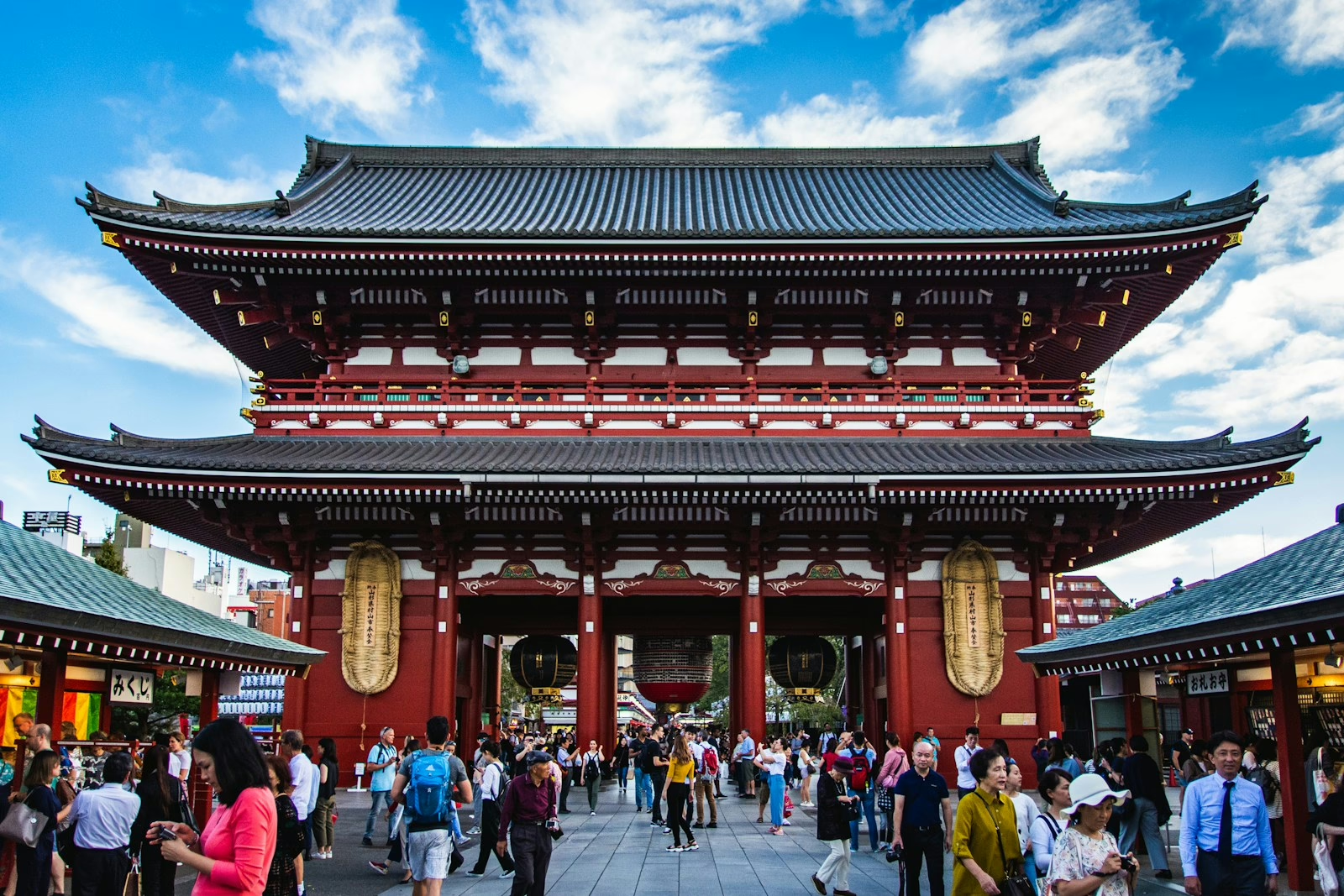
Visiting Tokyo’s temples and shrines isn’t just about snapping photos and checking boxes—it’s about stepping into sacred spaces where centuries-old traditions are still very much alive!
Before you even approach the main hall, you’ll encounter the temizuya (purification fountain), where a specific ritual of cleansing hands and mouth prepares visitors to enter respectfully.
Knowing this simple sequence shows you’re not just another tourist but someone who genuinely honors Japanese culture.
From understanding which areas are off-limits to cameras to choosing modest clothing that won’t raise eyebrows, these three essential protocols will transform your temple visits from awkward fumbling into graceful, meaningful experiences.
Purification Rituals at the Entrance
Before stepping into the sacred grounds of Tokyo’s temples and shrines, visitors must perform temizu, the traditional water purification ritual that cleanses both body and spirit at the chozuya (water pavilion).
This beautiful practice isn’t just for show—it’s a genuine act of respect that transforms casual tourists into mindful participants, preparing them to approach the divine with humility and clean hands!
The process involves specific steps at the stone basin, followed by the proper way to make offerings and prayers at the main hall, each gesture carrying centuries of meaning that connects modern Tokyo to its spiritual heritage.
The Water Pavilion: Step-by-Step Cleansing
Here’s your cleansing ritual breakdown:
- Fill the ladle with fresh water.
- Rinse your left hand, then right.
- Pour water into cupped hand, rinse mouth.
- Cleanse the ladle handle vertically.
Simple, mindful, transformative!
Coin Offerings and Prayer Procedures
After purifying hands and mouth, visitors naturally move toward the main prayer area, where the art of making an offering awaits.
Coin offerings typically involve tossing five-yen coins into the collection box—their Japanese name sounds like “connection”—then bowing twice, clapping twice, and bowing once more.
These prayer procedures aren’t mandatory rules but respectful gestures that honor centuries of tradition while you explore spiritual Tokyo freely!
Photography Rules and Restricted Areas
Why does that stunning vermilion torii gate or ancient wooden temple hall seem like the perfect photo op, yet sometimes visitors notice “no photography” signs posted nearby?
Understanding photography restrictions helps travelers respect sacred spaces while still capturing memories.
Certain restricted zones exist for spiritual and preservation reasons.
Here’s what savvy visitors should know:
- Interior halls housing sacred Buddhist statues or Shinto treasures typically prohibit all photography.
- Active prayer ceremonies and rituals require cameras to stay tucked away completely.
- Flash photography damages delicate centuries-old artwork and wooden structures.
- Some shrines allow exterior shots but restrict commercial photography without permits.
When signs aren’t posted, simply ask temple staff before snapping away!
Most outdoor areas welcome respectful photography, so travelers can still document their spiritual journey.
Proper Attire for Sacred Spaces
Beyond capturing the perfect shot, what visitors wear to these sacred sites matters just as much as how they photograph them.
Nobody’s policing your wardrobe at temple gates, but respecting traditional kimono customs means covering shoulders and knees—think modest, breathable fabrics perfect for Tokyo’s humid summers.
Tank tops and short shorts?
Save those for Shibuya’s shopping districts!
The sacred space footwear situation is beautifully simple: slip-on shoes reign supreme since you’ll be removing them constantly at temple interiors.
Wear your holey socks, and you’ll definitely get some side-eye from locals.
Pro tip—those ornate entrance mats aren’t just decorative; they’re your signal to pause, remove footwear, and step mindfully into spaces that have welcomed seekers for centuries.
Your considerate attire choices *unlock* genuine cultural connection!
Street Manners and Public Behavior in Tokyo
Finding your way through Tokyo’s streets comes with its own set of unwritten rules that separate confused tourists from savvy travelers who blend right into the urban rhythm.
From the left-side walking convention that keeps foot traffic flowing smoothly to the surprising absence of public trash bins (a legacy of subway security measures that turned into a cultural norm), these street manners reveal how Tokyo maintains its reputation as one of the world’s cleanest, most orderly cities.
Understanding these customs—whether it’s resisting the urge to munch on that convenience store onigiri while strolling or tracking down those elusive smoking areas—transforms a simple walk through Shibuya or Shinjuku into a respectful, friction-free experience.
Walking Rules: Keep Left and Watch Your Space
Walking through Tokyo’s bustling streets requires mastering one fundamental rule that keeps millions of pedestrians flowing smoothly: stick to the left side of sidewalks, walkways, and even escalators.
This choreographed movement creates an invisible highway system that lets everyone navigate freely without constant collision-dodging.
Your personal space bubble matters here, so avoid abrupt stops or diagonal wandering that disrupts the flow.
Essential walking guidelines include:
- Escalator behavior: Stand left, walk right—breaking this sacred rule earns disapproving glances
- Public park etiquette: Maintain awareness of joggers, cyclists, and strolling families sharing pathways
- Smartphone scrolling: Step aside before checking maps or messages
- Group conversations: Single-file formation prevents sidewalk blockages
Master these patterns, and you’ll glide through crowds like a seasoned Tokyoite, experiencing the city’s rhythm without frustrating fellow pedestrians!
The No-Eating-While-Walking Custom Explained
One of Tokyo’s most surprising cultural norms catches first-time visitors off guard: eating while walking down the street is generally considered impolite, even though convenience stores and street food vendors seem to tempt you at every corner.
The key to managing this custom?
Find a designated spot to pause and enjoy your snack!
Most vendors thoughtfully provide standing areas nearby, and you’ll spot locals doing exactly this—stopping briefly for their takoyaki or taiyaki before moving on.
This tradition stems from respecting public spaces and preventing accidental spills on crowded sidewalks.
Street snacking is absolutely encouraged, but public dining etiquette simply asks that you plant yourself somewhere first.
It’s a small adjustment that shows cultural awareness and keeps Tokyo’s streets pristine!
Smoking Regulations and Designated Areas
Why does Tokyo permit smoking in certain indoor establishments yet strictly prohibit lighting up while strolling down the street?
The city’s smoking bans prioritize pedestrian safety over indoor air quality, believe it or not!
Wandering smokers create burn hazards in crowded areas, especially for children at cigarette-height, so designated zones keep everyone safe.
Here’s what freedom-loving visitors need to know:
- Street smoking incurs hefty fines in most Tokyo wards
- Look for clearly marked smoking areas near station exits
- Many restaurants and bars still allow indoor smoking
- Convenience stores provide outdoor ashtrays for quick breaks
These designated zones might feel restrictive initially, but they’re strategically positioned throughout the city.
You’ll spot the telltale yellow painted squares with ashtrays, typically clustering around major intersections and transit hubs where smokers congregate freely.
Trash and Recycling: Why There Are No Public Bins
Visitors carrying empty coffee cups or snack wrappers quickly discover Tokyo’s most baffling urban mystery: public trash bins have virtually disappeared from the streets since the 1995 sarin gas attacks, when authorities removed them as a security measure.
The solution?
Embrace the Japanese practice of carrying your garbage home—you’ll see locals casually stuffing wrappers into bags without complaint.
Convenience stores provide a lifeline, offering dedicated bins near their entrances for items purchased there.
Understanding public trash disposal means accepting this carry-out culture as part of Tokyo’s remarkably clean streets.
When you do encounter bins, you’ll navigate Japan’s meticulous recycling regulations: separate compartments for plastics, cans, bottles, and combustibles.
It’s environmental consciousness meets urban security, creating a system that initially frustrates but ultimately impresses!
Business Card Exchange and Professional Settings in Tokyo
In Tokyo’s professional world, the exchange of business cards—known as *meishi*—carries as much weight as a firm handshake does in the West.
It transforms what might seem like a simple transaction into a carefully choreographed dance of respect and hierarchy.
The card itself becomes an extension of the person, demanding two-handed presentation with a slight bow, followed by a moment of genuine examination before carefully tucking it away (never, ever into a back pocket!).
Mastering this ritual, along with the subtle variations in bowing depth and duration depending on your counterpart’s status, can make the difference between a forgettable first impression and the foundation of a lasting business relationship.
The Ritual of Meishi: Presenting and Receiving Cards
The exchange of business cards—known as meishi kōkan—stands as one of Tokyo’s most sacred professional rituals, a choreographed dance where every hand position, bow angle, and moment of eye contact carries weight.
Master these fundamentals for respectful card exchange:
- Present with both hands, card facing recipient, readable from their perspective
- Receive cards gracefully, studying them carefully before placing on the table or in a card case
- Never write on, fold, or pocket a card immediately—treat it like a gift
- Maintain eye contact during the exchange while bowing slightly
This business card etiquette transforms simple introductions into meaningful connections!
Think of meishi as extensions of people themselves—respect the card, respect the person.
Your attention here signals professionalism.
Bowing Basics for Different Situations
Mastering Tokyo’s bowing etiquette requires understanding that not all bows carry equal weight—different situations demand different depths, durations, and degrees of formality.
The casual fifteen-degree nod works perfectly for greeting colleagues or thanking shop staff, while business meetings demand the deeper thirty-degree bow that shows genuine respect.
These cultural gestures become second nature once you’ve practiced!
For apologies or meeting senior executives, break out the forty-five-degree bow—hold it for two full seconds to demonstrate sincerity.
Pro tip: keep your back straight, hands at your sides, and eyes lowered.
Don’t stress about perfect execution; Japanese locals appreciate foreigners attempting these bowing variations, even imperfectly.
Watch others around you, mirror their movements, and you’ll navigate Tokyo’s social landscape like an insider!
Onsen and Public Bath House Rules in Tokyo
Visiting an onsen or sento in Tokyo offers one of the most authentic, relaxing experiences the city has to offer—but only if visitors understand the sacred (yes, sacred!) bathing protocols that govern these steamy havens.
The rules aren’t arbitrary; they’re rooted in centuries of tradition and a deep cultural respect for communal spaces, cleanliness, and the ritual of bathing itself.
From the mandatory pre-soak scrub-down to maneuvering tattoo restrictions and mastering the art of strategic towel placement, knowing these essential guidelines transforms a potentially awkward situation into a blissful immersion in Japanese culture.
Pre-Bath Washing Requirements
Why do Japanese bathers scrub down so meticulously before entering those inviting hot waters?
The answer’s beautifully simple: these communal pools are shared sanctuaries, not individual tubs.
Pre bath washing isn’t just courtesy—it’s fundamental respect for fellow bathers who expect pristine conditions.
Master these soap etiquette essentials before your first onsen visit:
- Sit on the provided stool at a washing station
- Thoroughly cleanse your entire body with soap and shampoo
- Rinse completely, leaving zero suds behind
- Give your stool and bucket a quick rinse for the next person
Think of it as your passport to relaxation!
Those low stools might feel awkward initially, but you’ll quickly appreciate this ritual that transforms bathing into something transcendent, communal, utterly Japanese.
Tattoo Policies You Need to Know
Tattoos and traditional Japanese bath houses don’t mix well.
Many onsen and sento facilities maintain strict tattoo restrictions, rooted in historical associations between ink and organized crime.
Here’s the reality: some establishments will turn you away at the entrance, while others post explicit “no tattoo” signs near the changing rooms.
However, don’t abandon your bathhouse dreams just yet!
Ink visibility policies vary markedly across Tokyo, with smaller, modern facilities proving more accommodating than traditional spots.
You’ve got options: search for tattoo-friendly onsen online, cover small tattoos with waterproof bandages, or book private family baths where restrictions disappear entirely.
Call ahead whenever possible—staff appreciate the courtesy, and you’ll save yourself an awkward rejection at the door!
Towel Usage and Modesty Standards
Once inside a bathhouse, towel etiquette becomes the next hurdle to master—and trust me, there’s a specific protocol that catches newcomers off guard every single time.
The rules aren’t about restricting your freedom—they’re practical guidelines that create comfortable shared spaces.
Here’s your essential towel etiquette breakdown:
- Small towels only enter the bathing area; large towels stay in the changing room.
- Never let your towel touch the bathwater—place it folded on your head or beside the tub.
- Wash completely at the shower stations before entering any communal bath.
- Modest dress means being naked; swimsuits are actually considered unhygienic.
The tiny towel won’t cover much, which initially feels awkward.
But everyone follows identical protocols, creating an unexpectedly relaxed atmosphere once you embrace the tradition!
Gift-Giving Customs for Visitors
Gift-giving in Tokyo isn’t just about the present itself—it’s a carefully choreographed dance of timing, presentation, and gracious refusal that reveals respect, thoughtfulness, and cultural awareness.
The beloved tradition of omiyage (souvenirs for friends, colleagues, and hosts) follows specific unwritten rules about when to present these tokens, while the art of wrapping transforms even simple gifts into elegant expressions of gratitude.
Visitors who master these customs, including the delicate ritual of politely declining a gift before accepting it, will find doors opening and relationships deepening in ways that transcend language barriers!
When and How to Present Omiyage
What’s the secret to making a memorable impression when visiting someone’s home or office in Tokyo?
Master the art of omiyage timing and gift presentation etiquette!
Present your carefully selected treats with both hands, offering a slight bow that signals respect and genuine appreciation.
Follow these essential guidelines:
- Timing matters: Hand over omiyage immediately after initial greetings, never during departure.
- Humble language: Accompany gifts with phrases like “tsumaranai mono desu ga” (this is just a small thing).
- Proper positioning: Present gifts at eye level or slightly lower, never above the recipient’s head.
- Remove shopping bags: Transfer omiyage to a proper gift bag beforehand.
These thoughtful gestures transform simple souvenirs into powerful bridges of connection, unlocking authentic Tokyo experiences beyond typical tourist boundaries.
Gift Wrapping and Presentation Protocol
The wrapping itself communicates respect in Tokyo, where presentation aesthetics hold equal weight to the gift’s contents—and savvy visitors quickly learn that pristine, professionally wrapped packages signal cultural fluency.
Department stores offer complimentary wrapping services that transform ordinary purchases into elegant presentations, so take advantage!
The presentation protocol demands using both hands when offering gifts, never tossing them casually across a table.
Avoid elaborate bows and flashy ribbons—Japanese gift wrapping favors understated elegance with clean folds, muted papers, and minimalist touches.
Skip opening gifts immediately upon receiving them; that’s considered impolite here.
Instead, graciously accept with a slight bow, set the package aside, and unwrap it later in private.
This restraint shows appreciation without awkward on-the-spot reactions that might embarrass either party.
Refusing Gifts Politely
Master refusing gifts politely through these essential steps:
- Initial refusal: Gently decline with “Sonna koto shinaide kudasai” (Please don’t go to such trouble).
- Second offer: Show appreciation but hesitate, creating respectful tension.
- Third acceptance: Finally accept with deep gratitude and a slight bow.
- Express thanks: Use “Arigatou gozaimasu” while receiving the gift with both hands.
This choreographed exchange shows you respect their generosity while demonstrating proper humility—pure Tokyo sophistication in action!
Common Mistakes First-Time Tokyo Travelers Make
Even the most well-intentioned travelers can stumble into awkward situations in Tokyo, where social norms operate on a completely different wavelength from Western expectations.
The most common faux pas—speaking loudly on trains, honking one’s nose at the dinner table, trampling through tatami rooms with outdoor shoes still on, and cutting lines or invading personal bubbles—stem from simple cultural differences rather than rudeness.
But they’ll definitely earn visitors some disapproving glances.
Understanding these particular pitfalls before arriving means travelers can navigate Tokyo’s unspoken rules with confidence, blending in seamlessly instead of standing out as clueless newcomers!
Speaking Too Loudly in Public Spaces
Why do so many first-time visitors find themselves on the receiving end of disapproving glances while chatting on Tokyo’s trains and sidewalks?
Tokyo operates on a cultural foundation of public whispering, where maintaining collective tranquility trumps individual expression.
Master these essentials:
- Train conversations: Keep voices library-level hushed or save discussions for after your stop
- Phone calls: Practice quiet phone etiquette by stepping outside or texting instead
- Restaurant dining: Animated laughter belongs in private izakayas, not family establishments
- Street chatter: Lower volumes naturally blend you into Tokyo’s serene urban rhythm
The unspoken social contract prioritizes communal peace over personal freedom of volume.
Embrace this quieter approach, and you’ll navigate Tokyo’s public spaces with genuine respect, earning appreciative nods instead of uncomfortable stares!
Blowing Your Nose in Public
What seems like an innocent response to allergies or a winter cold can trigger visible discomfort among Tokyo locals, leaving bewildered travelers wondering what invisible line they’ve just crossed.
Here’s the deal: nose blowing in public spaces ranks among Japan’s top etiquette taboos!
While sniffling repeatedly is perfectly acceptable (even preferable), loudly honking into a tissue makes people cringe.
The cultural logic?
Bodily sounds draw unwanted attention in a society that values discretion and consideration for others.
When allergies strike, discreetly excuse yourself to a restroom or step outside.
Keep tissues handy but use them sparingly in crowded trains, restaurants, or offices.
This simple adjustment to public etiquette demonstrates respect for Japanese sensibilities while maintaining your personal freedom to handle those inevitable sniffles however works best for you privately.
Wearing Shoes Indoors When You Shouldn’t
Just as bodily sounds can violate Tokyo’s unspoken rules, so too can the innocent act of keeping your shoes on trigger looks of horror from Japanese hosts and establishment owners.
Mastering shoe etiquette liberates you from awkward moments and shows respect for centuries-old customs.
Watch for these telltale signs demanding indoor footwear changes:
- Elevated entrances (genkan) where floor levels rise noticeably
- Shoe cubbies or racks positioned near doorways
- Slippers waiting in neat rows at thresholds
- Tatami mat rooms with their distinctive woven texture
Restaurants, temples, traditional inns, and homes all follow this sacred rule.
You’ll spot locals smoothly shifting into indoor footwear without breaking stride.
Practice this graceful shuffle, and you’ll navigate Tokyo like a seasoned resident rather than a clueless newcomer!
Queue Jumping and Personal Space Violations
Tokyo’s famously orderly queues represent more than simple lines—they’re sacred displays of mutual respect where cutting ahead ranks among the city’s gravest social sins.
Queue etiquette here demands patience, even when trains arrive every ninety seconds!
Stand behind the designated floor markings at train platforms, and never, ever squeeze past someone who clearly arrived first.
Personal space boundaries matter intensely too—maintain at least arm’s length distance when possible, especially during non-rush hours.
Japanese commuters value their invisible bubble of privacy, so resist the temptation to stand unnecessarily close while waiting.
Watch how locals position themselves: perfectly spaced, quietly patient, creating harmonious patterns that flow like choreographed dance.
Master this unspoken rule, and you’ll blend seamlessly into Tokyo’s beautifully synchronized urban rhythm!
How to Apologize and Show Respect When You Mess Up
When mistakes happen in Tokyo—and they absolutely will—knowing how to gracefully recover makes all the difference between an awkward moment and a respectful exchange that locals genuinely appreciate.
The magical phrase “sumimasen” (excuse me/I’m sorry) works wonders in countless situations, from bumping into someone on a crowded train to catching a server’s attention.
While the right body language—a slight bow, lowered eyes, and hands clasped together—transforms a simple apology into a sincere gesture that Japanese people instantly recognize and respect.
Master these two elements, and visitors gain the power to navigate social missteps with the confidence of someone who truly understands Tokyo’s unspoken rules.
The Power of “Sumimasen” in Daily Interactions
The word “sumimasen” might just be the most versatile tool in a visitor’s Tokyo vocabulary arsenal, functioning simultaneously as an apology, an excuse me, a thank you, and a conversation starter all rolled into one magical phrase.
Using “sumimasen” for apologies works brilliantly when you accidentally bump someone on a crowded train, while the role of “sumimasen” in gratitude shines when expressing appreciation for small kindnesses.
Master these essential applications:
- Getting a server’s attention at restaurants without seeming demanding
- Squeezing past people in packed subway cars during rush hour
- Acknowledging someone who held a door open
- Initiating questions when you’re gloriously lost in Shibuya’s labyrinth
This linguistic Swiss Army knife liberates you from awkward silences and cultural missteps, transforming potentially uncomfortable moments into smooth, respectful exchanges that locals genuinely appreciate!
Body Language That Conveys Sincerity
Words alone won’t cut it in Tokyo—your body must echo the sincerity that your mouth expresses, creating a physical performance of remorse that speaks louder than any perfectly pronounced “sumimasen.” Bowing transforms a simple apology into an authentic gesture of respect, with the depth and duration of your bow directly correlating to the severity of your mistake: a quick 15-degree nod works for minor bumps, while serious infractions demand a deep 45-degree bend held for a full two seconds.
Your body language broadcasts sincerity more effectively than words ever could!
Keep your hands at your sides or clasped in front, maintain a somber facial expression, and avoid fidgeting or checking your phone.
Eye contact before bowing shows acknowledgment, but lower your gaze during the bow itself—staring while bent forward reads as confrontational rather than apologetic.
Wrapping Up
Mastering Tokyo’s intricate social tapestry might feel like learning a new dance—awkward steps at first, but soon you’ll find your rhythm.
These cultural guidelines aren’t rigid chains but rather threads that weave travelers into the city’s lively fabric.
Embrace the occasional stumble, bow with sincerity, and remember that genuine effort always trumps perfection.
Tokyo rewards those who approach her customs with curiosity and respect, transforming nervous visitors into confident urban explorers.

